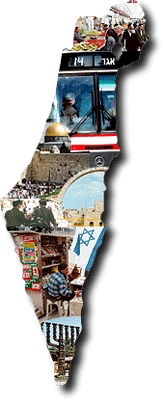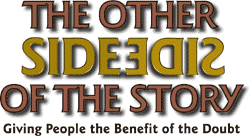Light Lines - Nitzavim/Vayelech
Parshat Nitzavim/Vayelech
23 Elul 5760 / 23 September 2000
Ohr Somayach Home Page
HEAD'S UP
"You are standing today, all of you, before your G-d" (Deuteronomy 29:9)
Standing means in this context "with your head held high." A person can hold his head high because he thinks a lot of himself and stands tall with self-important smugness. Or he can hold his head high for a different reason. Man is set between the animals and the angels. If he fills his life with vanity and the empty frenetic rush to fulfill his own desires, then he falls to the level of an animal. Really however, he is worse than an animal, because an animal is supposed to behave like an animal. A man isn't.
On the other hand, if he conquers his negative instincts, sanctifies and purifies his thoughts, his words and his actions, man raises himself to the level of an angel. In reality, however, he has raised himself higher than an angel, for angels have no negative drives to overcome. This makes man's ascent so much the greater. That's the other meaning of standing with your head held high: The whole year round a person is constricted by the pressures of the material world -- his head and his thoughts bent downwards like an animal, dealing with all the petty nonsense that is part of survival. On Rosh Hashana however, a day spent focused on the truly important spiritual aspects of life, (it's no coincidence that rosh in Hebrew means head) his head -- the head of the angel -- is held high over his body -- the animal. With the head of an angel, he must be even higher than an angel, for "Today you are all standing" -- with your heads held high.
|
Ohr Somayach Home Page |
 Selections from classical Torah sources which express the special relationship between the People of Israel and Eretz Yisrael SEPHARDIC SYNAGOGUES OF OLD JERUSALEM The few interconnecting Sephardic synagogues on Mishmerot Hakehuna street right next to the Jewish Quarter parking lot comprise one of the Holy City's most famous landmarks. They were built below street level because the Moslems who controlled the city at the time had an injunction against Jewish or Christian buildings being higher than Moslem ones in the area. The oldest of these synagogues -- the Eliyahu Hanavi and Rabbi Yochanan ben Zakkai synagogues -- go back over 400 years to the time when the Jewish community, evicted from its previous home which became a mosque, established these places of worship. |
|
Ohr Somayach Home Page |
Earlier this year, I bought myself a new tallis and a new tallis bag for the first time in more than 30 years. During the week, I would store the tallis and bag in a cabinet at our shul until they were needed on Shabbos. On one Shabbos, I arrived to find the tallis and bag missing from the cabinet. Needless to say, I was distressed. When I entered the main sanctuary, I saw someone wearing the same kind of tallis (of a distinctive style), with the same kind of bag (also distinctive) sitting close by. My initial thought was that this person had borrowed my tallis without realizing that it would be missed, but I did not know how to raise the subject with him without running the risk of embarrassing him, or even appearing to be accusatorial, such was my state of mind over losing my new tallis. So I said nothing to him.
At the kiddush, I saw a tallis bag like mine sitting in our social hall. After assuring myself that the other person had left the shul, I opened the bag and found that this, indeed, was my tallis (because there were some other identifying personal items in the bag). Relieved that I had recovered my tallis, but still thinking that it had been "borrowed," I mentioned to someone where I had found it, only to be told that the tallis bag had been sitting in the social hall for a week. Apparently, I had left it there on the previous Shabbos. A couple of weeks later, I saw that other person in shul again, wearing, of course, his tallis that just happened to match mine. It might not have been such a terrible thing had I inquired politely about the situation when the apparent borrowing occurred, but I learned a lot more by restraining myself and by never mentioning the person's name to anyone.
|
Ohr Somayach Home Page |
Eden for Yidden
Igor Doon wrote:
I am a Jew in Russia and I have one question for you that has interested me for a long time. What happens with a Jew after death? I know a non-Jewish concept about hell and heaven, but I know that such concept doesn't exist in Jewish tradition. Please explain me the point of view that Jewish tradition provides. Thank you beforehand.
Dear Igor,
Jews believe in life after death. We call it the World to Come. Gehinom -- a purification process -- is part of the World to Come. When a person dies, his soul gets a chance to "think objectively" about his lifetime spent on earth. Depending on how the person spent his life, this can be a painful process in which the soul mourns its bad deeds, lost opportunities and wasted potential.
Ultimately, the gehinom process is temporary, and eventually enables the person to enjoy the benefits of all the good things he did during his lifetime.
Nevertheless, Judaism emphasizes life in this world. Here's a parable to explain: A wealthy man goes on a cruise ship. The ship sinks, and he finds himself afloat in a tiny rubber raft. This raft is his only hope of arriving safely to his family, his mansion and all his wealth. Judaism looks at this world like a raft. By following the survival manual -- the Torah -- this little raft can bring us safely to the World to Come.
Light Insight | Love of the Land | The Other Side of the Story | Response Line Ohr Somayach Home Page |
Produced by the Office of Communications
Editor: Raphael Scott Leban
Production: Eliezer Shapiro
HTML Production: Michael Treblow
© 2000 Ohr Somayach International - All rights reserved. This publication may be distributed to another person intact without prior permission. We also encourage you to include this material in other publications, such as synagogue newsletters. However, we ask that you contact us beforehand for permission, and then send us a sample issue.
Ohr Somayach Institutions is an international network of Yeshivot and outreach centers, with branches in North America, Europe, South Africa and South America. The Central Campus in Jerusalem provides a full range of educational services for over 685 full-time students.









